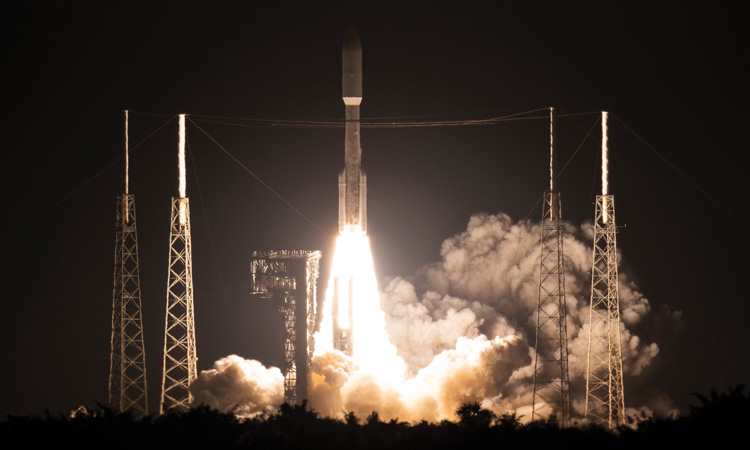 A United Launch Alliance Atlas V rocket takes off in December 2021 with the US Department of Defense’s Space Test Program Satellite-6, which hosts NASA’s Laser Communications Relay Demonstration. [NASA / J. Kowsky]
A United Launch Alliance Atlas V rocket takes off in December 2021 with the US Department of Defense’s Space Test Program Satellite-6, which hosts NASA’s Laser Communications Relay Demonstration. [NASA / J. Kowsky]
In December 2023, a payload on the International Space Station (ISS) known as ILLUMA-T began exchanging modulated infrared laser beams with a geosynchronous satellite some 35,000 kilometers above it. The experiment was designed to show how data—in this case high-definition video and photos of pets—can be relayed to the ground at high rates and without delay from spacecraft in low Earth orbit (LEO).
ILLUMA-T is the latest in a series of experiments NASA has conducted to put space-based laser communication through its paces—both for robotic and human spaceflight. Operating at optical frequencies, laser links can provide bandwidths that are orders of magnitude higher than those of conventional RF communications. The terminals used to send and receive messages generally have lower size, weight and power (SWaP) requirements than radio equipment, and because signals are transmitted in very narrow beams, they are far less susceptible to interference and eavesdropping.
Indeed, it is not just NASA and other space agencies that are embracing this technology. So too are other branches of government, especially the military, as well as industry. A number of companies, including SpaceX in the United States, are launching large fleets of satellites equipped with laser terminals into LEO to provide internet coverage across the globe—particularly in places ill-served by terrestrial links.
Challenges remain, notably in trying to mitigate for bad weather when sending signals to and from Earth. But according to Tom Wood at US IT and defense multinational CACI (which provided the modem and optical amplifiers for ILLUMA-T), satellite operators of all stripes are increasingly turning to laser communication. “Risks have [gotten] to the point where people are willing to deploy this thing,” he says.
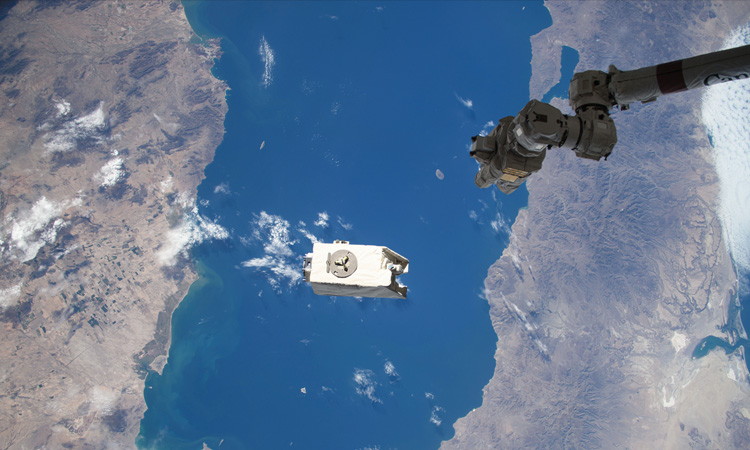 The ILLUMA-T payload above the Gulf of California, just after it was jettisoned by a robotic arm from the International Space Station into orbit in June 2024. [Johnson Space Center]
The ILLUMA-T payload above the Gulf of California, just after it was jettisoned by a robotic arm from the International Space Station into orbit in June 2024. [Johnson Space Center]
Benefits of bandwidth
Free-space optical links involve modulated laser beams being sent between transmitting and receiving telescopes, with transceivers at either end to convert between electronic and optical signals. The links can be entirely on the ground, connect a ground station to a satellite, or connect one satellite to another. Given the constraints of space payloads, ground stations can generally accommodate larger telescopes and other features such as adaptive optics to correct for atmospheric distortions of the optical signal.
Communicating at optical rather than radio frequencies, satellites can beam data back to Earth more quickly or in greater absolute quantities.
Communicating at optical rather than radio frequencies, satellites can beam data back to Earth more quickly or in greater absolute quantities. Bryan Robinson of the Massachusetts Institute of Technology’s Lincoln Laboratory, USA, cites the example of NASA’s Mars Reconnaissance Orbiter, which has sent back high-resolution images of a small percentage of the Martian surface since arriving at the red planet in 2006. “If you had an optical link,” he says, “you could map the entire surface in a few years.”
Space-based optical communication is not new. As far back as 1994, Japan’s Aerospace Exploration Agency (JAXA) sent infrared signals, at up to 1 megabit per second (Mbps), from a ground station in Tokyo to its ETS-VI satellite in geosynchronous orbit. Then in 2001, the European Space Agency (ESA) demonstrated the first intersatellite laser link when its Artemis geosynchronous satellite relayed data from France’s SPOT 4 LEO Earth observatory at a rate of 50 Mbps.
Getting to more regular deployment, however, has taken time. Besides the effort needed to make any technology space-worthy, Wood argues that going from radio to optical communications in space is “really a technical discontinuity.” For radio engineers used to working with gallium arsenide transistor amplifiers and seeing carrier frequencies perhaps double from one generation to the next, switching to optical signals and being confronted with a frequency rise of four orders of magnitude is “a big step,” he says.
One of the biggest challenges presented by the new technology is pointing. Although a laser beam’s narrowness limits energy consumption and eavesdropping, it also means communicating parties have to line up with one another extremely precisely—typically to within about 0.001°. This problem is only exacerbated when it comes to intersatellite links, with both spacecraft typically orbiting at 27,000 km/h.
However, says Wood, experience gained over the course of numerous demonstration missions has meant that the tracking and acquisition of one satellite by another has “proven to be manageable.” The result has been billion-dollar investments in satellite constellations that, when complete, will each see hundreds or thousands of satellites in LEO linked by laser beams to provide global broadband coverage.
The best-known of these is SpaceX’s Starlink network, which as of March 2024 comprised more than 5,000 optical communication terminals each transmitting at 100 Gbps, according to SpaceX engineer Travis Brashears. Other commercial networks are being set up by Amazon and Eutelsat OneWeb, while the US Space Development Agency (SDA) is launching satellites for communications and missile tracking. A Chinese company, Chang Guang Satellite Technology, has reportedly deployed more than 100 satellites and demonstrated 100-Gbps links, while the EU plans to deploy a LEO fleet for broadband internet known as IRIS² at some point in the next few years (although the program is reportedly suffering from cost overruns and delays).
Bad atmosphere
Such satellite-to-satellite links have the advantage of not having to contend with Earth’s atmosphere. Spacecraft communicating with the ground, in contrast, face the challenges of turbulence and clouds. The former causes channels to fade, which means that parts of the signal do not arrive at their destination—a problem in particular for uplinks, with smaller beams at ground level and less room for adaptive optics in space. Clouds, on the other hand, can block laser beams entirely, sometimes rendering communication with individual ground stations impossible for days on end.
 The operations room for ESA’s European Data Relay System in Ottobrunn, Germany. [Airbus]
The operations room for ESA’s European Data Relay System in Ottobrunn, Germany. [Airbus]
Since 2016, ESA has been receiving data from Earth observation satellites in LEO via two geostationary spacecraft. The latter remain in continuous contact with a given ground station and are visible to any LEO satellite for 50% of the time, whereas the LEO satellites themselves are limited to no more than 10 minutes of ground contact during each roughly two-hour orbit. As such, the use of relays reduces delays and enhances bandwidth—qualities that proved crucial, for example, in 2022 when transmitting images of wildfires in Greece. However, while the ESA relay sees laser beams link up the satellites in their different orbits, radio is still employed for the tricky passage back to Earth.
NASA has now carried out such a relay using an optical ground link instead, but not without difficulty. Known as the Laser Communications Relay Demonstration (LCRD), the experiment features a payload launched with a military satellite in December 2021. It uses two optical terminals to communicate simultaneously with a LEO spacecraft—initially the ISS—and a ground station at either Table Mountain in California or Haleakalā in Hawaii.
The experiment’s principal investigator, Dave Israel, says that the flight hardware proved to be “really solid” in initial tests carried out directly with the ground stations. But he explains that things got more complicated when hooking up ILLUMA-T, particularly in trying to establish contact between LCRD and the space station after one of them had carried out a maneuver. (ILLUMA-T was designed to send data from ISS experiments to the ground, but Israel says that in the end NASA management decided not to hook up payload and experiments.)
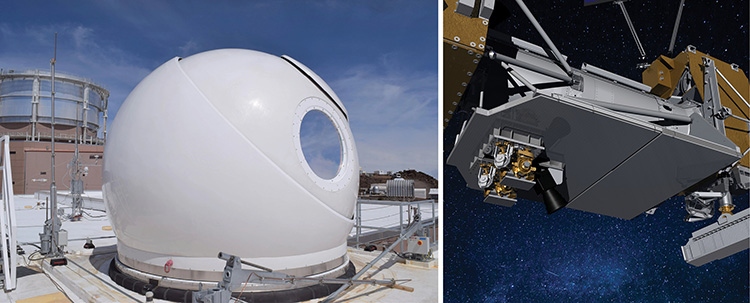 LCRD’s Optical Ground Station 2 in Haleakalā, HI, USA (left) and LCRD’s two optical modules and a star tracker onboard the Space Test Program Satellite-6 (right). [NASA / NASA Goddard Space Flight Center]
LCRD’s Optical Ground Station 2 in Haleakalā, HI, USA (left) and LCRD’s two optical modules and a star tracker onboard the Space Test Program Satellite-6 (right). [NASA / NASA Goddard Space Flight Center]
Even trickier have been conditions on Earth. Israel points out that both ground stations are in good locations—high up and relatively cloudless—and says that day-to-day rain and shine have been more or less as expected. But he notes they weren’t prepared for more one-off phenomena such as blizzards, wildfires and volcanic eruptions—all things that have limited uplink and downlink time. “It is these acts of God that we need to take into account,” he says.
Launched in May 2022, the NASA mission known as TBIRD has achieved data rates of 200 Gbps and delivered 4.8 TB in a single five-minute contact with the ground.
Built for speed
An alternative strategy is to go direct—beaming back data from LEO to ground so quickly that even a few minutes is enough to do the job. Given the delay imposed by the satellite’s limited field of view, Robinson explains that this approach would not suit emergency response and other applications where time is of the essence. But it might suffice for less urgent data, such as those on climate change. Plus, he says, the shorter link implies smaller telescopes for a given data rate—further reducing SWaP.
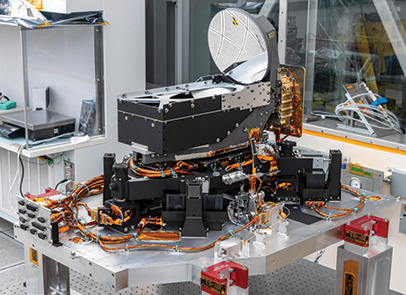 The Deep Space Optical Communications flight laser transceiver before being installed in NASA’s Psyche spacecraft. [NASA / JPL-Caltech]
The Deep Space Optical Communications flight laser transceiver before being installed in NASA’s Psyche spacecraft. [NASA / JPL-Caltech]
Destination Mars
NASA’s Deep Space Optical Communications (DSOC) experiment was designed to test free-space laser links at greater distances than ever before—and make it possible in the future to exchange images, video and other data with astronauts on Mars. The project’s flight transceiver uses a 22-cm telescope and photon-counting camera to send and receive data from two ground stations in Southern California.
As DSOC project technologist Abi Biswas explains, Mars is about 1,000 times farther away than the moon, so communications need a roughly million-fold increase in performance—implying large telescopes and novel technology. For example, he says, lasers must have a very high peak to average power, so that at least a few photons in each pulse reach their target. Pointing, meanwhile, calls for a software controller that in turn requires an isolation system to minimize high-frequency vibrations.
Launched in October 2023 as part of the Psyche mission to study a metal-rich asteroid, DSOC’s flight transceiver has continued to send data back to Earth from ever-greater distances. In December, it beamed a video of a NASA employee’s cat from 19 million miles away at a rate of 267 Mbps, and in June it achieved 8 Mbps from 251 million miles away—which Biswas says is in line with the inverse-square law, given the much higher rate that could have been achieved in theory at the shorter distance.
For Biswas, these results are “a complete game changer” compared with radio. But he points out that 5 of 24 slots allocated by Psyche to DSOC had to be scrapped because of bad weather, and adds that astronomers at the Palomar ground station have been “very cautious” about opening the observatory’s dome during the day, which is necessary for communication with a Mars mission. Getting access to a suitably large daytime telescope—probably a new one—might take until the early to mid-2030s, he estimates.
Robinson has worked on a NASA mission that operates on just this principle—TeraByte InfraRed Delivery, or TBIRD. It involves a CubeSat the size of a tissue box using a 1.2-cm telescope to transmit data at high rates from LEO to a 1-m telescope on the ground, while the latter sends tracking and error-correction data upward at much lower speeds. With TBIRD splitting the downlinked data into a sequence of blocks, the ground station tells the satellite which blocks did not get through properly so that the satellite can resend them.
Launched in May 2022, TBIRD has achieved data rates of 200 Gbps and delivered 4.8 TB in a single five-minute contact with the ground. Robinson says that, as with LCRD, weather has been a factor. But he explains that the very high data rate provides leeway when high-altitude cirrus clouds roughly halve the signal strength, as well as the means to exploit even a brief gap in thicker clouds. “You don’t need a completely clear sky to make it work,” he says.
Nevertheless, he adds that successful full-scale operations would rely on having several ground stations, each in a different location with different weather. Israel agrees, saying that the experience with LCRD shows that just two ground stations are definitely not enough. As to how many would suffice, he does not have a definite answer but reckons that six or perhaps even nine would be necessary to span the globe.
Thinking inside the box
Beyond Earth orbit, NASA is also experimenting with lasers in deep space. Back in 2013, it received around 600 Mbps optically from a robotic spacecraft in lunar orbit, and it has now installed a laser terminal in the Orion spacecraft—which is due to carry astronauts toward the moon for the Artemis II mission in September 2025. Indeed, high-bandwidth communication ought to be possible on a Mars mission as well, given the success of another demonstration in deep space (see “Destination Mars”).
Others, however, are more focused on expanding terrestrial technology. Christian Fuchs and colleagues at the German Aerospace Center (DLR) have developed a laser terminal called O4C that is a third the size of a standard CubeSat, weighs a mere 400 g and consumes just 8.5 W of power. Fuchs says it took them a little longer than anticipated to squeeze everything down and yet retain space-worthiness, but that once launched into LEO in 2021, the system “performed flawlessly”—taking a photo, processing it onboard, then sending it at 100 Mbps to the ground for display.
Fuchs explains that while O4C is far slower than TBIRD, it works with a simpler ground station. Employing intensity modulation, its data can be detected by a 200-μm-wide photodiode placed behind the receiving telescope. In contrast, TBIRD relies on coherent detection—modulating the phase to expand the bandwidth—which means coupling the light captured by the telescope into a single-mode fiber just 9 µm in diameter, making the system more complex and expensive.
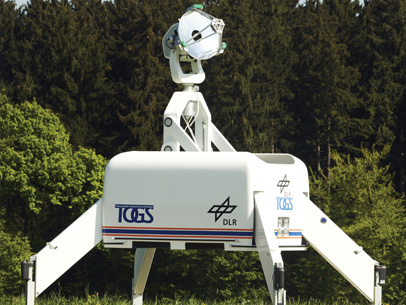 The Transportable Optical Ground Station operated by DLR, which can be deployed globally in its cargo-sized container. [ESA]
The Transportable Optical Ground Station operated by DLR, which can be deployed globally in its cargo-sized container. [ESA]
With the DLR terminal being sold commercially by Tesat Spacecom, Fuchs and his colleagues are now adapting the design for use in intersatellite links—which are trickier because they can’t rely on a large ground telescope to collect the diverging beam from a small space aperture. To try and overcome this problem, researchers at Northumbria and Durham universities in the UK have developed a new kind of steerable mirror to enable larger receiving apertures. Durham’s Cyril Bourgenot says that thanks to this and other innovations, they expect to build a CubeSat terminal capable of sustaining intersatellite links of 1 Gbps at up to 1000 km range.
At the same time, the DLR researchers are also developing CubeSats for quantum communication—one is due to launch this summer for initial statistical measurements, and a second one about a year later to demonstrate experimental quantum key distribution. The challenge, Fuchs says, is being able to transmit and receive single photons despite the small diameters of the satellites’ telescopes.
The universal terminal
CubeSats have literally taken off in the last few years, with well over 2,000 launched to date. But some remain convinced that more-conventional satellites are needed to accommodate the telescopes, solar panels and other equipment able to maintain high-speed data links in a big constellation. Joachim Horwath is the founder and chief technology officer of Mynaric, which spun off from DLR in 2009 to mass-produce optical terminals for satellites (weighing several hundred kilograms) in LEO. “CubeSats are nice to make lower-resolution images on Earth, but when it comes to commercial services, I am doubtful,” he says.
Mynaric is a prime contractor for the SDA, an arm of the US Space Force charged with rapidly building up a constellation of hundreds of satellites in LEO to provide communication links and surveillance for the country’s military. SDA’s philosophy is to provide “good-enough capabilities” sooner rather than the perfect satellite fleet at a later date, aiming to launch a new tranche of satellites, each slightly more advanced than the last, every two years. Starting last year, it has so far put 27 satellites into orbit.
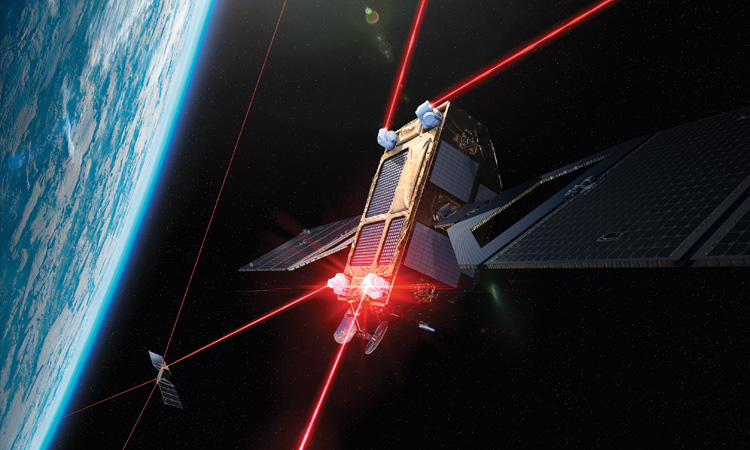 Artist’s impression of a satellite in a low Earth orbit constellation with optical terminals made by Mynaric. [Mynaric]
Artist’s impression of a satellite in a low Earth orbit constellation with optical terminals made by Mynaric. [Mynaric]
Horwath underlines the versatility of his company’s technology, explaining that the optics in its terminals can work over a range of wavelengths and polarizations. Versatility is also the name of the game for Morio Toyoshima and colleagues at the National Institute of Information and Communications, Japan, who have developed prototypes of two kinds of miniaturized optical terminal for applications in space, in the air and on the ground. The terminals have different-sized telescopes—diameters of 3 cm and 9 cm—and can be combined with two different types of modem, being envisaged in particular for use in 5G and 6G networks.
The US Defense Advanced Research Projects Agency (DARPA) has instead set the ambitious goal of creating what Horwath describes as a “universal optical terminal.” The Space-Based Adaptive Communications Node (Space-BACN) would be reconfigurable in orbit so that it could exchange data with currently incompatible terminals, acting as a kind of translator between them. It would, if all goes well, be capable of operating at 100 Gbps, consume no more than 100 W and cost less than US$100,000.
More specifically, Space-BACN aims to develop three products: a cheap optical telescope that can couple into a single-mode fiber, a reconfigurable modem suited to different waveforms and operating up to 100 Gbps, and a new type of command-and-control system that links government and commercial satellites. In 2022, DARPA selected 11 teams from industry and academia to work on the three areas, then in late 2023 whittled the participants down to seven to move ahead with development.
Don’t kill the radio star
While many in the sector argue that space-based optical communication will expand the reach of today’s internet, Israel also sees free-space links as integral to a project being developed by NASA, ESA and JAXA known as “LunaNet.” The idea is to link human and robotic users on and around the moon, providing them with network, navigation and hazard-alert services. And just as fiber optic cable provides the main terrestrial trunk routes, relay satellites would establish high-bandwidth optical links to Earth from which multiple user connections could be aggregated—“just as not everybody has their own fiber link across the ocean,” says Israel.
However, satellite constellations are unlikely to provide the lion’s share of terrestrial internet, says Fuchs, who argues that 100 Gbps is simply not enough to support users connecting en masse. Indeed, he points out that optical fiber provided this kind of bandwidth 20 or 30 years ago. Although he has no doubt that the constellations currently being assembled will work, he believes they will be used “to connect people in remote areas, not cities.”
In a similar vein, Wood feels that optical technology will complement radio, rather than replace it. He says that while laser terminals are the obvious choice for high-bandwidth links, “it is hard to beat radio for cost and reliability” when it comes to low bandwidth. Robinson agrees, arguing that many satellite operators are unwilling to accept the possibility that a link might not be available when needed—particularly given the problem posed by clouds. “That might lead you to keep radio systems, even just as backup in those critical situations,” he says.
NASA’s Deep Space Optical Communications project technologist Abi Biswas says that the technology up in space “is only going to get better.”
Human spaceflight is also likely to see lasers and radio used side by side. Steve Horowitz, project manager for Orion’s Optical Communications System, says that on Artemis II radio will continue to provide command, telemetry and safety data, whereas the optical terminal will be used to beam back recorded data, images and high-definition video (at up to 260 Mbps when near the moon). Unlike the data from Artemis I, most of which were only analyzed after the spacecraft returned to Earth, he explains that those from Artemis II will instead be analyzed by experts while the mission is ongoing. And that, he says, “is super valuable.”
NASA’s Deep Space Optical Communications project technologist Abi Biswas, however, cautions that the problem of ground infrastructure remains. This, he says, “is not really a technology gap but an engineering gap”—and in particular a question of “whether NASA has the appetite to come up with the budget in a reasonable amount of time.” On the other hand, he says that the technology up in space “is only going to get better.” Horowitz concurs, and argues that as laser terminals get smaller and lighter, spacecraft will have more resources to carry out scientific measurements. “Optical,” he says, “is powerful stuff.”
Edwin Cartlidge is a freelance science writer based in Rome, Italy.
References and Resources
-
C. Schieler et al. Small Satellite Conference, SSC19-VI-02 (2019).
-
C. Schmidt et al. IEEE International Conference on Space Optical Systems and Applications, 175 (2022).
-
D.J. Israel et al. SPIE Photonics West, 20240001299 (2024).
-
C. Graham et al. Aerospace 11, 330 (2024).
-
M.E. Grein et al. Conference on Lasers and Electro-Optics, 20230016540 (2024).
-
A. Carrasco-Casado et al. Photonics 11, 545 (2024).
